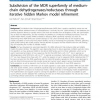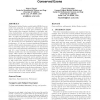439 search results - page 61 / 88 » Maximum entropy methods for biological sequence modeling |
BMCBI
2006
13 years 9 months ago
2006
Background: One type of DNA microarray experiment is discovery of gene expression patterns for a cell line undergoing a biological process over a series of time points. Two import...
BMCBI
2007
13 years 9 months ago
2007
Background: Our goal is to develop a state-of-the-art protein secondary structure predictor, with an intuitive and biophysically-motivated energy model. We treat structure predict...
BMCBI
2010
13 years 9 months ago
2010
Background: The Medium-chain Dehydrogenases/Reductases (MDR) form a protein superfamily whose size and complexity defeats traditional means of subclassification; it currently has ...
BMCBI
2007
13 years 9 months ago
2007
Background: Serial analysis of gene expression (SAGE) is used to obtain quantitative snapshots of the transcriptome. These profiles are count-based and are assumed to follow a Bin...
RECOMB
2004
Springer
14 years 9 months ago
2004
Springer
Phylogenetic hidden Markov models (phylo-HMMs) have recently been proposed as a means for addressing a multispecies version of the ab initio gene prediction problem. These models ...



